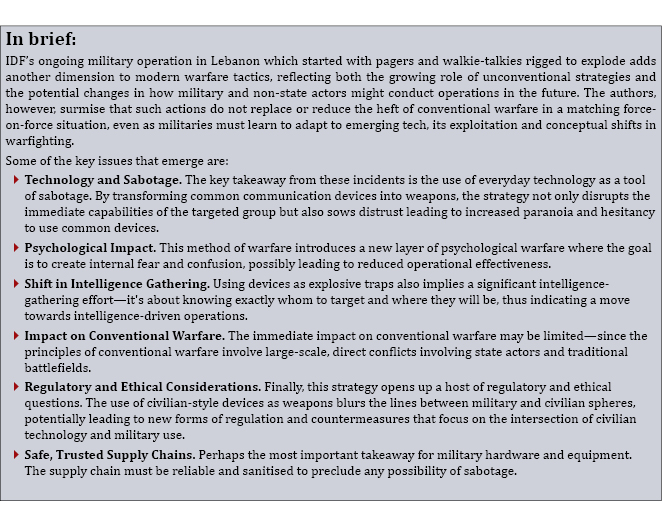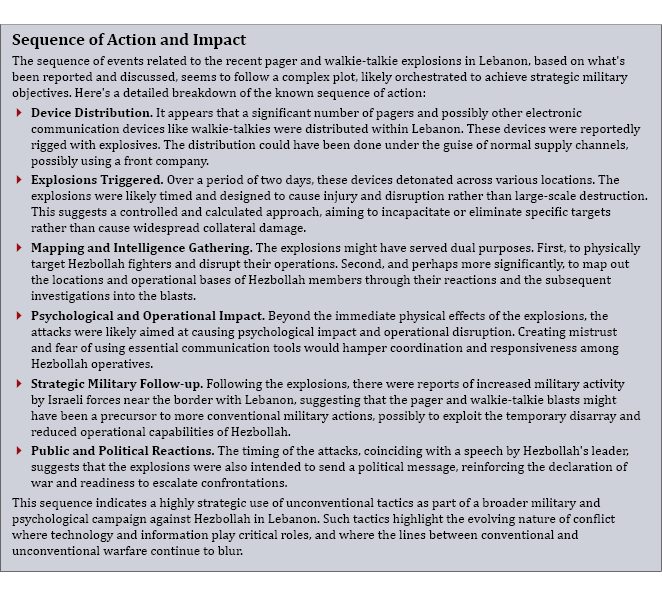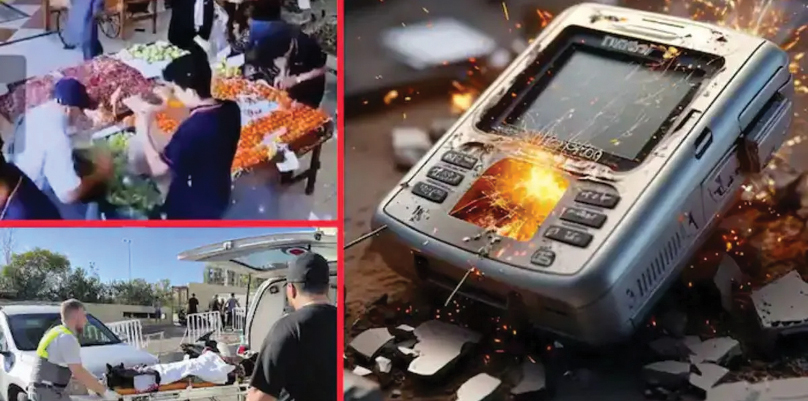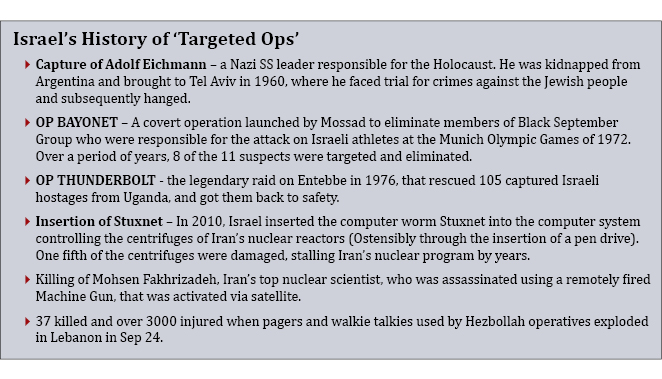
Articles
The Game-Changing Pager Blasts: A New Era of Warfare ?
Sub Title : As the pager blasts shook everyone across the globe, we take a look at the events that followed and analyse the impact of such innovative methods on the battlefield
Issues Details : Vol 18 Issue 4 Sep – Oct 2024
Author : Ashwani Sharma, Editor-in-Chief & Ajay Kumar
Page No. : 26
Category : Military Affairs
: October 8, 2024
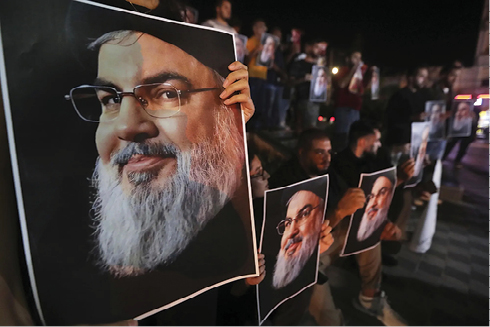
How Innovative Blasts Sparked a Massive Offensive
The recent pager blasts in Lebanon stunned the world with their innovation, scale, and precision. Follow-up attacks deepened insecurity, forcing global military strategists to re-evaluate battlefield tactics, highlighting the impact of psychological warfare and innovative, cost-effective terror methods
The recent pager blasts in Lebanon shook the world, capturing global attention due to their innovation, audacity, scale, and the shock they generated. Follow-up incidents involving exploding radio sets, solar panels, and household items amplified the panic, leaving Hezbollah, its leadership, and the wider public feeling vulnerable and insecure. This reaction was inevitable. Military intellectuals, analysts, and global observers were quick to take note of this novel development—a first of its kind in modern warfare.
Subsequent opinions and analyses have prompted academia to reflect on whether these innovations could redefine the battlefield and usher in a new era of warfare. Much has also been debated regarding the implications for daily life, particularly with respect to mass transportation systems especially civil aviation, which continue to face growing threats from terror groups globally. This incident serves as a reminder that no one is truly safe, illustrating how easy, cost-effective, and sudden such acts of violence can be. Terrorist organisations constantly seek ways to strike unsuspecting victims at minimal expense. The analysis of this event will continue even as law enforcement agencies, in collaboration with the scientific community, strive to develop methods for mitigating such threats.
Focusing on the military implications, it is essential to first revisit the specifics of the incident and its resulting damage to assess its long-term impact on warfare. This feature covers the sequence of actions in detail (see the box for the number of casualties reported publicly, though actual figures may be higher).
Initial reactions from the global military community were understandably shaped by the shock and awe the blasts provoked. These incidents can be considered an advanced form of IED attacks, although on a massive scale, marked by precise coordination and planning, with sophisticated technology and flawless execution. The conceptual ingenuity behind targeting Hezbollah’s leadership and cadres through these IEDs cannot be understated. Despite collateral damage—tragically including women and children—the primary objective was Hezbollah and its neutralisation, and this brief focuses solely on that aspect. Further details on the impact follow below.
In the aftermath of the pager/walkie-talkie blasts, Hezbollah targets have come under a barrage of air raids, missile strikes, and precision bombings. These strikes have focussed on Hezbollah’s leadership, weapons stations, ammunition depots, and other critical war resources. Speculation surrounds a potential ground assault by IDF forces as well. The precision and intensity of these strikes have reverberated across global communities. As the situation develops, we will better understand the scope of Israel’s planned offensive against Hezbollah. However, one thing is already apparent: the pager blasts were merely the beginning, signalling the larger offensive to follow. They were essentially preparatory actions preceding the main military thrust. The real blow to Hezbollah’s warfighting capability is unfolding now through Israel’s broader offensive operations.
The blasts achieved their aim by neutralising a significant portion of Hezbollah’s leadership and cadre in a surprise strike. This has caused both operational paralysis and psychological demoralisation, weakening Hezbollah’s response to Israel’s ongoing offensive. As a result, Hezbollah’s surviving leaders have been forced into hiding, struggling to maintain effective communication. Almost as an immediate follow up to the strike, Israel struck again the next day, targeting and killing the Hezbollah Chief Hassan Nasrallah, and virtually decapitating the Hezbollah leadership. It is now clear that this was part of a deliberate plan to incapacitate the Hezbollah’s decision making ability, as a prelude to a likely ground action in Southern Lebanon.
As days pass by, we will witness the full extent of IDF’s offensive which has been precise and ferocious till now. Netanyahu has already warned Hezbollah’s patron, Iran, to stay out of the conflict, threatening it with severe consequences if it intervenes. As events continue to unfold, Israel’s broader strategy and tactics will become more apparent. For now, it’s safe to conclude that the pager blasts, while playing a small but psychologically critical role, were part of a larger, well-coordinated military plan. The broader offensive remains the decisive factor, but the pager blasts serve as a reminder to military strategists of the importance of innovation and the element of surprise on the battlefield.
A clear pointer concerning modern warfare is the evolution and effectiveness of precision weapons and munitions. It is not only economical in terms of money and effort, precision also ensures quick outcomes and reduces collateral damage.
Use of technology and information stand out as other battle winning factors. Tech used in this operation was almost perfect and timed very well. Information gained was precise and the action further resulted in acquisition of more intelligence about numbers, identity and location of Hezbollah cadres.
This enduring lesson, however – ‘to surprise the enemy when and where they least expect it’, remains as relevant as ever as the pager blasts demonstrated.
Silent Signals: How Israel Crippled Hezbollah with Exploding Pagers
At 3:30 in the afternoon of 17 September, Ashraf Marwan, (all names changed) a mid-level regional commander of the Hezbollah, heard a familiar beep on his pager. He had discarded his mobile smart phone for this antique AP924 pager a few months ago, following a diktat from the Hezbollah leadership – as had all other operatives. It was an outdated system of communication, but allowed them to receive secure text messages, without detection from the Israelis. This message seem to be coming from the Hezbollah Chief, Hassan Nasrallah himself, and was obviously very important. As he tried to open the message, the pager began beeping loudly and incessantly and started vibrating uncontrollably in his hands. Uncomprehendingly, he punched different buttons, and pressed hard on the pager with both hands to stop it, but the beeping only increased till the pager suddenly exploded, ripping off his hands and virtually decapitating him.
In another corner of Beirut, Fatima, the nine year-old daughter of a local Hezbollah leader heard her father’s pager beep in the living room. Thinking it would be an important message, she ran to give it to him, when it exploded, killing her instantly. At the same time in downtown Beirut, Ishfaq Ilahi was riding his motorcycle with his wife and infant child, when he heard a familiar beep from the pager in his pocket. As he reached his hand to answer it, the phone exploded, shattering his hands and genitals and forced his motorcycle to crash, killing him and seriously injuring his wife and child, along with two other bystanders on the road.
These explosions were part of an estimated 1600 others, which killed 25 and injured another 600 in a series of coordinated blasts that took place simultaneously across Lebanon. The very next day at a funeral for the dead Hezbollah fighters, Walkie-talkies used by Hezbollah members exploded inexplicably in their hands. The second wave of explosions killed 12 and injured 2300, and caused panic amongst the bystanders who screamed, “Switch off your phone, take out the batteries.” Solar panels and other electronic devices also detonated, leading Lebanese to be fearful of even activating basic household appliances such as toasters. Even as the Hezbollah Chief was promising vengeance, Israeli jets flew overhead, breaking the sound barriers in a deliberate display of strength, and then attacked the safe house of Ibrahim Aqil, the senior most Hezbollah leader in South Lebanon, killing him and 18 others. In less than 48 hours the senior leadership of the Hezbollah had been crippled in one of the most audacious covert operations in history.
The Case of the Exploding Pagers
Israel has a history of launching daring covert operations, and this has been one of its most successful. It is comparable to other equally audacious operations like the insertion of the STUXNET virus into Iran’s nuclear reactors, that forced its centrifuges to spin uncontrollably and eventually damaged it, setting back its nuclear programs by years. A senior Iranian nuclear scientist was also assassinated in the heart of Tehran by using a AI assisted remotely operated machine gun, that was fired via a satellite. Even the recent attack that killed senior Hamas leader Ismail Haniyeh, in the heart of Teheran, has been attributed to it. The use of high-tech technology to strike deep into the enemy is reportedly the handy work of Unit 8200, a highly secretive Israeli intelligence unit which incorporates some of the country’s brightest minds and is known for out-of-the-box thinking.
Like the earlier operations, this operation too has not been claimed or denied by the Israelis – but has all their signs. In spite of the ethical concerns that it has raised, it has succeeded in virtually decapitating the Hezbollah leadership and rendering them incapable of communicating with each other for fears that other devices would be similarly infiltrated.
This meticulously planned and executed operation began over a year ago when the Hezbollah Chief Hassan Nasrallah realised that senior Hezbollah members were being assassinated, because Israel could identify precise locations through their mobile telephones. In February this year, a visibly distressed Nasrallah announced in a publicly televised address to his followers, “The phone in your hand is the Israeli agent. Bury it. Put it in an iron box and lock it.” He felt the answer was to go low-tech and rely on older pagers and walkie-talkies for communication, which though slow, would not disclose their locations. Even before he passed instructions for all Hezbollah operatives to switch to pagers, the Israelis had swung into action. They established a shell firm called BAC, based in Budapest, which produced pagers and other devices on behalf of a Taiwanese company called Gold Apollo. Two other similar companies were also created. When Hezbollah gave the order for 5000 pagers to Gold Apollo, this company passed the production rights to BAC which could manufacture them under licence. BAC had been producing ordinary pagers and electronic equipment for other clients, but this order is what they had been waiting for. The order was separately processed in which the batteries were laced with 2 to 3 ounces of explosive PETN, which were designed to explode on a remote signal delivered on the pager itself. The ‘special’ pagers were shipped to Lebanon and Syria and then issued to virtually every Hezbollah operative of the local rank of colonel upwards. Perhaps the Israelis were waiting for just the right time, to activate these deadly devices. And at 3:30 p m on 17 September, they received the fatal signal which caused them to explode simultaneously and killed or injured the chain of command in one crippling stroke.
The Signal for the Next Phase
This strike marks a significant escalation in the Israel -Hezbollah war which has been going on for years now. The two have been trading strikes virtually every day since 07 October 23, and the constant attacks had forced Israel to evacuate over 72,000 settlers in the area adjoining Southern Lebanon. Israel seems to have completed its major operations in Gaza, irrespective of world pressure and now the logical next target is the Hezbollah. It has moved around 70,000 troops towards Lebanon, and from the manner in which they have conducted operations, are slowly targeting the Hezbollah leadership and cadres as a prelude to the ground operations. In spite of Hezbollah’s numerical strength and their impressive arsenal of weaponry, it is now in disarray. Many of the top operatives have been killed or incapacitated, their communication has been shattered, and in spite of the bravado, it will be difficult for them to coordinate their activities, in case of a Israeli offensive. Israel now seems to be setting the stage, by which they could strike into Southern Lebanon, eliminate Hezbollah’s missile and rocket batteries and perhaps even advance up to the line of the Litani River, in which they could establish some kind of buffer zone, and eventually use for the creation of new settlements.
There are lessons to be learnt from this strike, though as always, it has two sides. Terrorist organisations too could resort to these same tactics, with disastrous consequences. It implies that the world over, nations will have to revamp their supply chains to ensure that products shipped into the country are not tampered with. After all, if the Israelis could create such a vital link in the supply chain, what is to prevent other organisations from infiltrating the manufacturing process in virtually any item from refrigerators, cars, aircraft, phones, and any other electronic gadgets to cause mayhem in another country. It is an effective way of countering terrorism, but has ethical connotations, especially with damage to innocents and bystanders. But it brings out how high technology can be effectively and innovatively utilised to execute audacious covert operations and attain aims as minimal cost and effort.



